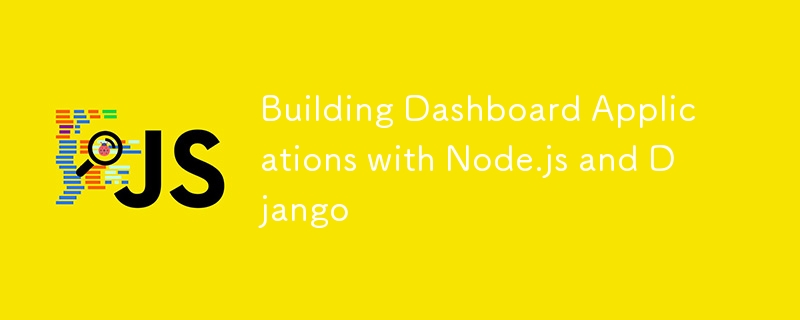
소개
지난 2 주 동안 나는 대시 보드 응용 프로그램을 구축하는 데 사용되는 두 가지 저명한 기술인 Node.js 및 Django를 탐구했습니다. 이 문서는 이러한 프레임 워크에 대한 포괄적 인 개요를 제공하여 고유 한 기능, 장점 및 실제 응용 프로그램을 강조하는 것을 목표로합니다. Node.js와 Django는 모두 강력한 프레임 워크이며, 각각의 개발 요구와 선호도를 제공합니다.
대시보드 애플리케이션용 Node.js
개요
Node.js는 Chrome의 V8 엔진을 기반으로 구축 된 JavaScript 런타임으로 개발자가 서버 측에서 JavaScript를 실행할 수 있습니다. 비 차단, 이벤트 중심의 아키텍처로 유명하여 실시간 응용 프로그램에 적합합니다.
주요 기능
비동기 처리 : node.js는 각각이 끝날 때까지 기다리지 않고 동시에 여러 요청을 처리합니다. 이 기능은 라이브 데이터를 표시 해야하는 실시간 대시 보드에 중요합니다.
확장 성 : Node.js는 확장 가능하도록 설계되었으므로 개발자는 점점 더 많은 사용자와 데이터를 처리 할 수있는 응용 프로그램을 구축 할 수 있습니다.
Express Framework : Express는 웹 및 모바일 애플리케이션을 개발하기위한 강력한 기능 세트를 제공하는 최소적이고 유연한 Node.js 웹 애플리케이션 프레임 워크입니다. 라우팅 및 처리 요청을 단순화하여 대시 보드의 백엔드를보다 쉽게 구축 할 수 있습니다.
- node.js
가있는 대시 보드 구축
node.js를 사용하여 대시 보드 응용 프로그램을 작성하려면 다음 단계를 따르십시오.
-
node.js 설정 : node.js를 설치하고 프로젝트 디렉토리를 설정하십시오.
<: :> 서버 생성 : Express를 사용하여 API 요청을 처리하고 대시 보드를 제공하는 서버를 만듭니다.
데이터 소스 통합 : 데이터베이스 또는 외부 API에 연결하여 데이터를 가져옵니다. http 요청에 Axios와 같은 라이브러리를 사용하십시오
프론트 엔드 빌드 : HTML, CSS 및 JavaScript를 사용하여 사용자 인터페이스를 개발하십시오. 데이터 시각화 라이브러리를 통합하여 차트 및 그래프를 표시합니다
실시간 기능 구현 : 라이브 데이터 업데이트에 Socket.io와 같은 웹 소켓 또는 라이브러리를 사용하십시오.
-
대시 보드 응용 프로그램 용 Django
- 개요
Django는 빠른 개발과 깨끗하고 실용적인 디자인을 장려하는 고급 파이썬 웹 프레임 워크입니다. "배터리로 인한 배터리"철학을 따라 개발자가 강력한 응용 프로그램을 신속하게 구축 할 수 있도록 많은 내장 기능을 제공합니다.
주요 기능
내장 관리자 인터페이스 : Django는 대시 보드 데이터를 쉽게 만들고 관리하는 데 유용한 데이터 모델을 쉽게 관리 할 수있는 강력한 관리자 인터페이스가 제공됩니다.
ORM (Object-Relational Mapping) : Django의 ORM을 사용하면 개발자가 원시 SQL 쿼리 대신 Python 객체를 사용하여 데이터베이스와 상호 작용할 수 있습니다. 이것은 데이터 관리 및 통합을 단순화합니다
보안 : Django는 CSRF, SQL Injection 및 XSS와 같은 일반적인 웹 취약점에 대한 보호를 포함하여 강력한 보안 기능을 제공합니다.
템플릿 엔진 : Django의 템플릿 엔진은 개발자가 HTML 페이지를 동적으로 생성 할 수 있으므로 대시 보드보기를 쉽게 만들고 업데이트 할 수 있습니다.
- django 로 대시 보드 빌드
Django를 사용하여 대시보드 애플리케이션을 구축하려면 다음 단계를 따르세요.-
- Django 설정: Django를 설치하고 Django의 명령줄 도구를 사용하여 새 프로젝트를 시작하세요.
- 모델 정의: Django의 ORM을 사용하여 대시보드에 표시되는 정보를 나타내는 데이터 모델을 만듭니다.
- 뷰 생성: 요청을 처리하고 응답을 반환하는 뷰를 개발합니다. Django에 내장된 일반 뷰를 사용하여 일반적인 작업을 단순화하세요.
디자인 템플릿: Django의 템플릿 언어를 사용하여 대시보드 레이아웃을 위한 HTML 템플릿을 만들고 동적 콘텐츠를 통합합니다.
데이터 시각화 구현: Chart.js와 같은 라이브러리를 사용하거나 타사 패키지를 통합하여 데이터를 차트와 그래프로 표시합니다.
결론
Node.js와 Django는 모두 대시보드 애플리케이션을 구축하는 데 탁월한 선택이며 각각 장점이 있습니다. Node.js는 실시간 업데이트 및 비동기 작업을 처리하는 데 탁월하므로 대화형 대시보드에 이상적입니다. 내장된 기능과 강력한 보안을 갖춘 Django는 신속한 개발과 강력한 데이터 관리가 우선시되는 애플리케이션에 매우 적합합니다. 둘 중 하나를 선택하는 것은 특정 프로젝트 요구 사항, 선호하는 프로그래밍 언어, 필요한 기능 유형에 따라 다릅니다.
위 내용은 Node.js 및 Django를 사용하여 대시 보드 응용 프로그램 구축의 상세 내용입니다. 자세한 내용은 PHP 중국어 웹사이트의 기타 관련 기사를 참조하세요!


